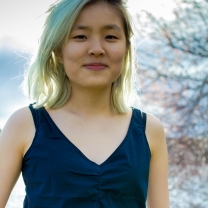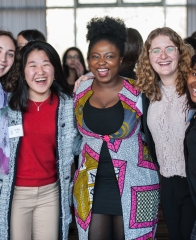 / An Evening with Margaret Atwood
Subscribe
/ An Evening with Margaret Atwood
Subscribe

Margaret Atwood refuses labels. In her words, The Handmaid’s Tale is not “feminist literature,” and the MaddAdam trilogy is not “science fiction.” As applied, those labels are incomplete or inaccurate. The only label she cautiously accepts is “speculative fiction,” defined as writing that hypothesizes what the future might hold. The New Yorker dubbed her “Prophet of Dystopia” in a recent profile, revisiting The Handmaid’s Tale and its lingering resonance with current events in tones of both admiration and alarm; in the accompanying photograph, Atwood’s close-mouthed smile and bright eyes gleam knowingly. What is it that she sees on the horizon?
Our evening with Atwood (May 2nd, 2017, 6:00-7:30pm) began with a recounting of her life from childhood to the early days of her writing career. Her speculative fiction is similarly concerned with the past: the predictive power of her works comes from their roots in history (as long as history continues to repeat itself). For instance, The Handmaid’s Tale contains pointed references to America under Reagan’s presidency and Puritan society, and Oryx and Crake uses real biotechnological advances as inspiration for Atwood’s vision of a technocratic apocalypse.
More than thirty years past the release of The Handmaid’s Tale and ten years past that of Oryx and Crake, the recognition we feel now when reading either of these works is disturbing. Unlike Greek prophecy though, speculative fiction does not have to be self-fulfilling. The texts show us that we have not yet heeded the words of our prophet—but also that we still have time to act.
And so, we sat assembled before the author perched on the Alumnae Hall stage. After Atwood reminisced about penning and literally stitching together a short story about an ant at six years old, a final question turned our gaze towards the future. Can we ask what you’re writing now?
She declined to respond. You can ask what I’m writing now… I will not tell you. She had been lured into revealing hints about a budding novel as a young writer, but ended up haunted by her answer later when she attempted to drop the project. It seems even Atwood’s own future occasionally evades her divinatory powers.
Even when untrue, her words render the future in far more vivid color and detail than the cryptic hints of prophets past. The cost of the clarity of her vision is that the cloud of the unknown still lingers ahead, obscuring even the single path Atwood illumines in any given work. At the same time, the path leading to dystopia is well-defined, and where her fiction asks what if this goes on?, we are able to ask what if we stopped now? Our story is not predestined to end with Oedipus and Cassandra in tragedy, and our relationship with Atwood does not end in us inevitably stumbling towards the bleak human civilizations, mere heartbeats beyond our present, that her texts depict. Rather than headlines noting the “shocking” or “terrifying” accuracy of speculative fiction and its recurring themes, we need to emphasize how to escape these patterns and trends. Her “prophecy” should instead push us to explore the endless array of alternate paths still unknown, and her optimism that we will succeed in defying her is captured in the Future Library Project.
In this endeavor, a writer will be announced each year from 2014 onwards to contribute a manuscript into an archive, unreleased to the public save for its title. By the end of a century, all one hundred submissions will be released in an anthology to be printed on pages made from one thousand trees being grown in Norway during this story accumulation period. Margaret Atwood is the first contributor with her piece Scribbler Moon.
The Future Library Project is one of hope. Atwood writes—and her protagonists Offred and Jimmy, by spoken and written word, record their stories—because she believes that humanity will persist until the project’s release. More specifically, she believes in the future reader.
To our shared misfortune, that future reader will not be one of us. That future reader will be of a different era, of different cultures, with different concerns. In a hundred years, we have to hope that Atwood’s work will be dated, obsolete, unlike The Handmaid’s Tale with its increased relevance today. While the Oracle of Delphi counseled the Greeks for centuries, each age had its own individual prophet rise to the occasion. May the year 2114 bring Atwood’s successor, and may her or his writing reflect an unfamiliar but beautiful world.
Alexandria Guo is a student of the Wellesley College Class of 2019, studying Computational Sciences and researching the democratization of biotechnology.
Photo Credit: Kathy Hutchins, "Atwood at Premiere of Handmaid’s Tale," via Shutterstock, 17 Jun 2017.







